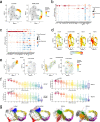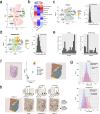Single-cell ATAC and RNA sequencing reveal pre-existing and persistent cells associated with prostate cancer relapse
- PMID: 34489465
- PMCID: PMC8421417
- DOI: 10.1038/s41467-021-25624-1
Single-cell ATAC and RNA sequencing reveal pre-existing and persistent cells associated with prostate cancer relapse
Abstract
Prostate cancer is heterogeneous and patients would benefit from methods that stratify those who are likely to respond to systemic therapy. Here, we employ single-cell assays for transposase-accessible chromatin (ATAC) and RNA sequencing in models of early treatment response and resistance to enzalutamide. In doing so, we identify pre-existing and treatment-persistent cell subpopulations that possess regenerative potential when subjected to treatment. We find distinct chromatin landscapes associated with enzalutamide treatment and resistance that are linked to alternative transcriptional programs. Transcriptional profiles characteristic of persistent cells are able to stratify the treatment response of patients. Ultimately, we show that defining changes in chromatin and gene expression in single-cell populations from pre-clinical models can reveal as yet unrecognized molecular predictors of treatment response. This suggests that the application of single-cell methods with high analytical resolution in pre-clinical models may powerfully inform clinical decision-making.
© 2021. The Author(s).
Conflict of interest statement
GA receives a reward from the Institute of Cancer Research for his role as an inventor of abiraterone. GA has received honoraria, consulting fees, or travel support from Janssen, Astellas, Pfizer, Novartis, Bayer, Amgen, AstraZeneca, Sanofi, and Sapience, grant support from Janssen and Astellas, and is a principal investigator for clinical trials sponsored by Janssen, Pfizer, and Astellas. TM receives consultant fees from Astellas, Janssen, and Bayer; lecture fees from Novartis, Janssen, and Sanofi. He is a stockholder of Arocell ab. The remaining authors declare no competing interests.
Figures







References
Publication types
MeSH terms
Substances
Grants and funding
LinkOut - more resources
Full Text Sources
Medical
Molecular Biology Databases

